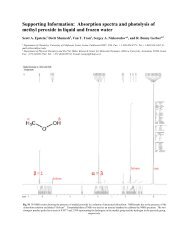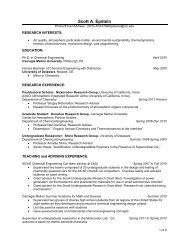Overtone spectroscopy of H2O clusters in the vOH - UCI Aerosol ...
Overtone spectroscopy of H2O clusters in the vOH - UCI Aerosol ...
Overtone spectroscopy of H2O clusters in the vOH - UCI Aerosol ...
- No tags were found...
You also want an ePaper? Increase the reach of your titles
YUMPU automatically turns print PDFs into web optimized ePapers that Google loves.
194316-10 Nizkorodov et al. J. Chem. Phys. 122, 194316 2005ter, peak<strong>in</strong>g at N5–6, and qualitatively much more consistentwith <strong>the</strong> Ar–H 2 O dimer results. Although fur<strong>the</strong>r experimentswill be necessary to establish this def<strong>in</strong>itively, <strong>the</strong>results plausibly suggest that vibrational predissociation <strong>of</strong>Ar–H 2 O from 02 − 0 00 has strong contributions from <strong>the</strong>near resonant V-V pathway:Ar – H 2 O02 − 0 00 → H 2 Ov OH =1;v bend =2;J+ Ar, E released 240 cm −1 ,which would <strong>the</strong>n phot<strong>of</strong>ragment <strong>in</strong>to <strong>the</strong> high-N OH distributionsobserved <strong>in</strong> Fig. 10. The smoothness <strong>of</strong> <strong>the</strong> result<strong>in</strong>gOH state distribution would also be consistent with severaldifferent J states produced <strong>in</strong> Eq. 4, s<strong>in</strong>ce photolysis <strong>of</strong>s<strong>in</strong>gle J states <strong>of</strong> H 2 O generally result <strong>in</strong> much more structuredOH quantum state distributions for example, see Figs.9 and 10. As a f<strong>in</strong>al comment, it is worth not<strong>in</strong>g that <strong>the</strong> OHstate distributions result<strong>in</strong>g from <strong>the</strong> photolysis <strong>of</strong> overtoneexcited H 2 O 2 i.e., 7193 cm −1 band are remarkably similarto <strong>the</strong> above results for Ar–H 2 O. This might aga<strong>in</strong> suggestsubstantial bend<strong>in</strong>g excitation <strong>in</strong> one or more <strong>of</strong> <strong>the</strong> HOHproducts. Because <strong>of</strong> <strong>the</strong> higher b<strong>in</strong>d<strong>in</strong>g energy <strong>of</strong> H 2 O 2 vsAr–H 2 O D 0 1700 cm −1 vs 140 cm −1 , however, predissociation<strong>in</strong>to same H 2 Ov OH =1;v bend =2;J states is now notenergetically possible. Never<strong>the</strong>less, several bend-excitedchannels rema<strong>in</strong> energetically open such as formation <strong>of</strong>H 2 Ov OH =0;v bend 3 and H 2 Ov OH =1;v bend 1. Basedon <strong>the</strong> requirement <strong>of</strong> vibrationally enhanced photodissociationcross section at 193 nm, <strong>the</strong> observed distributions plausiblyarise from photolysis <strong>of</strong> H 2 Ov OH =1;v bend 1,J.However, it is worth not<strong>in</strong>g that s<strong>in</strong>ce <strong>the</strong> action spectra deriveboth <strong>the</strong>ir sensitivity and specificity from strong vibrationallymediated skew<strong>in</strong>g <strong>of</strong> <strong>the</strong> photodissociation cross sections,this need not be representative <strong>of</strong> <strong>the</strong> full distribution<strong>of</strong> predissociated H 2 O. Never<strong>the</strong>less, <strong>the</strong>se studies makesimple predictions and highlight some <strong>in</strong>terest<strong>in</strong>g directionsfor fur<strong>the</strong>r exploration with quantum state resolution <strong>in</strong> <strong>the</strong>ejected H 2 O, as perhaps could be studied by IR phot<strong>of</strong>ragmentationrecoil <strong>spectroscopy</strong>. 56,57IV. CONCLUSION AND SUMMARYThe comb<strong>in</strong>ation <strong>of</strong> slit jet expansions with i IR pumpvibrational excitation, ii vibrationally selective excimerphotolysis, followed by iii state-resolved laser-<strong>in</strong>ducedfluorescence prob<strong>in</strong>g <strong>of</strong> fragments, reveals itself as a powerfulspectroscopic tool for extend<strong>in</strong>g traditional vibrationallymediated photodissociation methods <strong>in</strong>to <strong>the</strong> overtone region<strong>of</strong> <strong>the</strong> water <strong>clusters</strong>. Rich vibrational structure has been observed<strong>in</strong> vibrationally mediated dissociation spectra <strong>of</strong>H 2 O/Ar mixtures under supersonically cooled conditions <strong>in</strong><strong>the</strong> vic<strong>in</strong>ity <strong>of</strong> <strong>the</strong> first OH-stretch<strong>in</strong>g overtones <strong>of</strong> H 2 O. Theobserved resonances can be assigned to overtone transitions<strong>of</strong> Ar–H 2 O and H 2 O 2 based on <strong>the</strong>ir spectral structure andphotodissociation dynamics and, <strong>in</strong> favorable cases, evenpermitt<strong>in</strong>g direct detection <strong>of</strong> resolved rotational structure.Indeed, this is <strong>the</strong> first reported gas-phase spectra <strong>of</strong> H 2 O4dimer overtone <strong>in</strong> <strong>the</strong> gas phase that reveals both agreementand disagreement with currently available <strong>the</strong>oretical models.The use <strong>of</strong> time delayed IR pump and photolysis lasersallows direct observation <strong>of</strong> predissociation dynamics <strong>of</strong>H 2 O complexes on <strong>the</strong> 10 ns 1 s time scale, as demonstratedon v OH =2 <strong>of</strong> Ar–H 2 O <strong>clusters</strong>. For sufficiently longlived vibrational states, this method provides a novel schemefor <strong>in</strong>itiat<strong>in</strong>g photochemical events <strong>in</strong>side size-selected andquantum-state-selected <strong>clusters</strong>. In conjunction with parallelstudies <strong>of</strong> <strong>the</strong> isolated monomer, solvent effects on <strong>the</strong>phot<strong>of</strong>ragmentation dynamics <strong>of</strong> H 2 O can be directly probedby comparison with vibrationally mediated photodissociation<strong>of</strong> <strong>the</strong> same free rotor state H 2 O state <strong>in</strong> <strong>the</strong> absence <strong>of</strong> <strong>the</strong>perturb<strong>in</strong>g Ar atom. Specifically, vibrationally mediated dissociation<strong>of</strong> H 2 O with<strong>in</strong> Ar–H 2 O complex clearly produceshotter rotational OH distributions as well as promot<strong>in</strong>g partialnonadiabatic energy transfer between 3/2,1/2 andlambda-doublet electronic levels. A simple physical modelfor this would be <strong>in</strong>tracluster collisions between <strong>the</strong> recoil<strong>in</strong>gOH phot<strong>of</strong>ragment and Ar atom. 40,41 At a more challeng<strong>in</strong>glevel, however, <strong>the</strong>se data reflect <strong>the</strong> detailed phot<strong>of</strong>ragmentationdynamics <strong>of</strong> H 2 O <strong>in</strong> <strong>the</strong> presence <strong>of</strong> a s<strong>in</strong>gle solventatom, yet with <strong>the</strong> considerable spectroscopic simplification<strong>of</strong> aligned, fully quantum-state-selected reagents as well as<strong>the</strong> special <strong>in</strong>tracluster advantage <strong>of</strong> well-determ<strong>in</strong>ed impactparameter and total angular momentum.ACKNOWLEDGMENTSF<strong>in</strong>ancial support by <strong>the</strong> National Science Foundationand Air Force Office <strong>of</strong> Scientific Research is gratefully acknowledged.A.E.W.K. wishes to acknowledge gratitude toJILA for Visit<strong>in</strong>g Fellowship support dur<strong>in</strong>g <strong>the</strong> time <strong>of</strong> thisresearch.1 M. Van Thiel, E. D. Becker, and G. C. Pimentel, J. Chem. Phys. 27, 4861957.2 T. R. Dyke and J. S. Muenter, J. Chem. Phys. 60, 2929 1974.3 T. R. Dyke, K. M. Mack, and J. S. Muenter, J. Chem. Phys. 66, 4981977.4 T. R. Dyke, J. Chem. Phys. 66, 492 1977.5 R. H. Page, J. G. Frey, Y. R. Shen, and Y. T. Lee, Chem. Phys. Lett. 106,373 1984.6 M. F. Vernon, D. J. Krajnovich, H. S. Kwok, J. M. Lisy, Y. R. Shen, andY. T. Lee, J. Chem. Phys. 77, 471982.7 D. F. Coker, R. E. Miller, and R. O. Watts, J. Chem. Phys. 82, 35541985.8 S. Wuelfert, D. Herren, and S. Leutwyler, J. Chem. Phys. 86, 37511987.9 Z. S. Huang and R. E. Miller, J. Chem. Phys. 88, 8008 1988.10 Z. S. Huang and R. E. Miller, J. Chem. Phys. 91, 6613 1989.11 R. Lascola and D. J. Nesbitt, J. Chem. Phys. 95, 7917 1991.12 J. B. Paul, R. A. Provencal, and R. J. Saykally, J. Phys. Chem. A 102,3279 1998.13 L. B. Braly, K. Liu, M. G. Brown, F. N. Keutsch, R. S. Fellers, and R. J.Saykally, J. Chem. Phys. 112, 10314 2000.14 K. L. Busarow, R. C. Cohen, G. A. Blake, K. B. Laughl<strong>in</strong>, Y. T. Lee, andR. J. Saykally, J. Chem. Phys. 90, 3937 1989.15 R. C. Cohen and R. J. Saykally, J. Phys. Chem. 96, 1024 1992.16 L. H. Coudert and J. T. Hougen, J. Mol. Spectrosc. 139, 2591990.17 G. T. Fraser, R. D. Suenram, and L. H. Coudert, J. Chem. Phys. 90, 60771989.18 R. S. Fellers, C. Leforestier, L. B. Braly, M. G. Brown, and R. J. Saykally,Science 284, 945 1999.Downloaded 26 May 2005 to 128.200.198.26. Redistribution subject to AIP license or copyright, see http://jcp.aip.org/jcp/copyright.jsp





